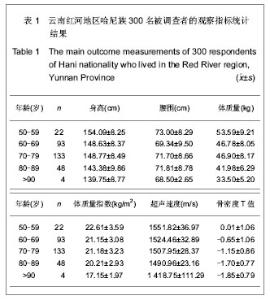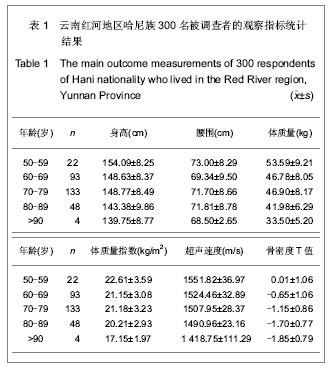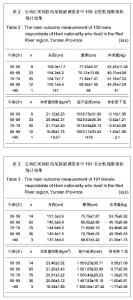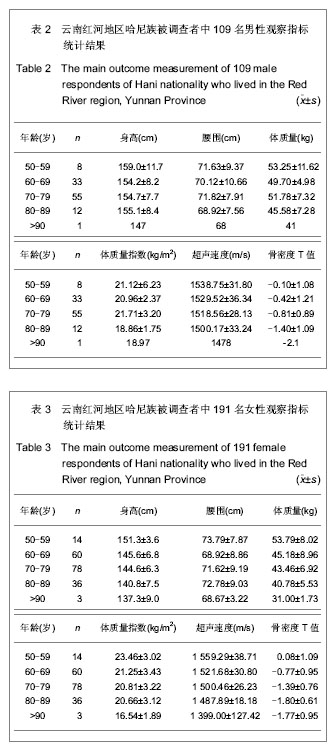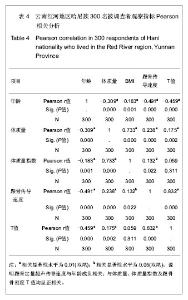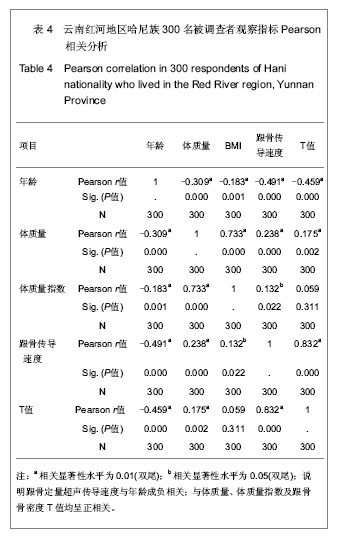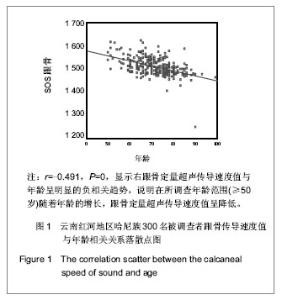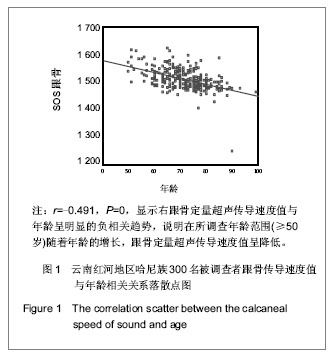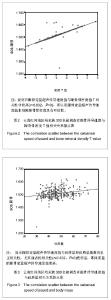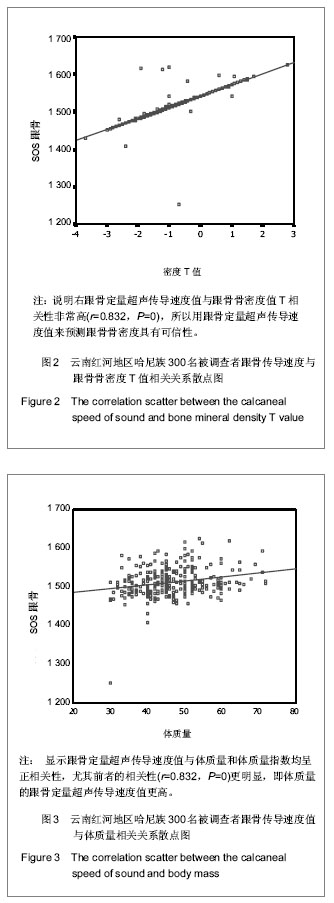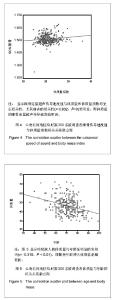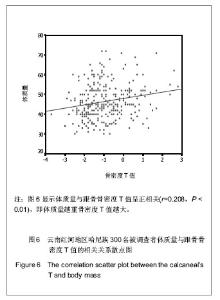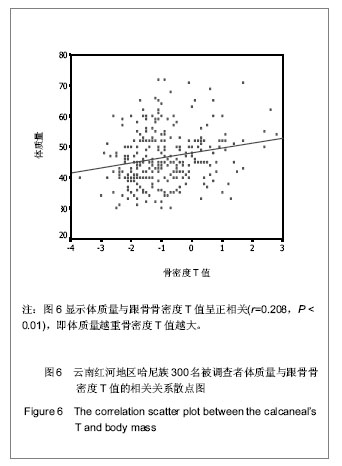Chinese Journal of Tissue Engineering Research ›› 2013, Vol. 17 ›› Issue (20): 3785-3792.doi: 10.3969/j.issn.2095-4344.2013.20.024
Previous Articles Next Articles
Association between calcaneal ultrasound speed and body mass and body mass index among the Hani minority from the Red River region, Yunnan Province
Luo De-jun1, Zhao Hong-bin2, Ji Yong1, Wu Guo-yong1, Tang Xu1, Luo Yong-Gang1, Lei Hai1, Zhang Hui1, Chen Yun1
- 1 Department of Orthopedics, the People’s Hospital of Jianyang City, Jianyang 641400, Sichuan Province, China
2 Department of Emergent Trauma Surgery, the First Affiliated Hospital of Kunming Medical University, Kunming 650031, Yunnan Province, China
-
Received:2012-08-15Revised:2012-10-09Online:2013-05-14Published:2013-05-14 -
About author:Luo De-jun★, Master, Attending physician, Department of Orthopedics, the People’s Hospital of Jianyang City, Jianyang 641400, Sichuan Province, China luodejunde@qq.com -
Supported by:the National Natural Science Foundation of China, No. 30560043; Yunnan Provincial Science and Technology Department & Kunming Medical University Special Funds, No. 2007C0004R
CLC Number:
Cite this article
Luo De-jun, Zhao Hong-bin, Ji Yong, Wu Guo-yong, Tang Xu, Luo Yong-Gang, Lei Hai, Zhang Hui, Chen Yun. Association between calcaneal ultrasound speed and body mass and body mass index among the Hani minority from the Red River region, Yunnan Province [J]. Chinese Journal of Tissue Engineering Research, 2013, 17(20): 3785-3792.
share this article
| [1] Rachner TD, Khosla S, Hofbauer LC. Osteoporosis: now and the future. Lancet.2011;377(9773):1276-1287.[2] Nordin BE,Redefining Osteoporosis. Calcif Tissue Int.2008; 83(6): 365–367.[3] Tuck SP, Francis RM.Osteoporosis.Postgrad Med J.2002; 78(923):526-532.[4] Megyesi MS, Hunt LM, Brody H. A critical review of racial/ethnic variables in osteoporosis and bone density research. Osteoporos Int.2011;22(6):1669-1679. [5] Guo L. Linchuang Huicui.2010;27(6):474-476.郭丽. 凉山彝族地区中老年人骨密度影响因素调查分析[J].临床荟萃,2010,27(6):474-476.[6] Holick MF,Vitamin D Deficiency. N Engl J Med.2007;357(3): 266-281.[7] Malhotra N,Mithal A.Osteoporosis in Indians. Indian J Med Res. 2008;127(3):263-268.[8] Zhao HB,Yu ZP,Wang JW,et al.Kunming Yixueyuan Xuebao. 2010,31(4):47-49.赵宏斌,俞志鹏,王建伟等.云南红河地区哈尼族髋部骨折流行病学调查[J].昆明医学院学报,2010,31(4):47-49.[9] Miller PD, Siris ES, Barrett-Connor E, et al. Prediction of fracture risk in postmenopausal white women with peripheral bone densitometry:evidence from the National Osteoporsis Risk Assessment. J Bone Miner Res.2002;17(12):2222-2230.[10] Sosa M,Saavedra P, Pino-Montes J,et al.Post- Menopausal women with Colles' fracture have lower values of bone mineral density than controls as measured by quantitative ultrasound and densitometry. J Clin Densitom.2005;8(4):430-435.[11] Su RK,Liu XM.Zhongguo Guzhi Shusong Zazhi.2003;9(3): 220-221.苏汝堃,刘兴漠.中老年骨折妇女超声骨质测量中参数分析[J].中国骨质疏松杂志,2003,9(3):220-221.[12] Holroyd C,Harvey N,Dennison E. Epigenetic influences in the developmental origins of osteoporosis. Osteoporos Int.2012; 23(2):401-410. [13] Ferrari SL. Osteoporosis:a complex disorder of aging with multiple genetic and environmental determinants. World Rev Nutr Diet.2005;95:35-51.[14] Gao WK,Bai F,Wang W, et al. Zhongguo Guzhi Shusong Zazhi.2011;17(11):941-944.高文魁,白峰,王伟,等.高原低氧环境下骨质疏松大鼠模型的骨代谢生化指标观察[J].中国骨质疏松杂志, 2011,17(11):941-944.[15] Adler RA. Osteoporosis in Men:What has Changed ? . Curr Osteoporos Rep.2011;9(1):31-35[16] Patel R, Black GM, Fogelman I. Peripheral and central measurements of bone mineral density are equally strongly associated with clinical risk factors for osteoporosis. Calcif Tissue Int.2007;80(2):89-96.[17] Rhee EJ,Oh KW,Lee WY,et al. Age,body mass index,current smoking history ,and serum insulin-like growth factor-1 level associated with bone mineral density in middle-aged korean men.J Bone miner Metab.2004;22(4):392-398.[18] Jen KL,Buison A,Darga L,et al. The relationship between blood leptin level and bone density is specific to ethnicity and menopausal status. J Lab Clin Med. 2005;146(1):18-24.[19] Paniagua MA, Malphurs JE, Samos LF. BMI and low bone mass in an elderly male nursing home population. Clin Interv Aging.2006;1(3):283-287.[20] Travison TG, Araujo AB, Esche GR, et al. Lean mass and not fat mass is associated with male proximal femur strength. J Bone Miner Res.2008;23(2):189-198.[21] Zhou SJ,Huang XF,Pu HQ,et al. Zhongguo Guzhi Shusong Zazhi. 2008,14(4):263-265.周善金,黄秀峰,浦洪琴,等.毛南族健康女性身高、体重、足长、体重指数与跟骨BUA的关系[J].中国骨质疏松杂志,2008,14(4): 263-265.[22] Adami S,Giannini S,Giorgino R,et al.Effect of age,weight and lifestyle factors on calcaneal quantitative ultrasound in premenopausal women;the ESOPO study. Calcif Tissue Int.2004;74(4):317-321.[23] Huang CS,Huang HH,Pu HQ.Zhongguo Laonianxue Zazhi. 2010;30(14):2045-2046.黄昌盛,黄何华,浦洪琴. 年龄、体重、体重指数对广西京族中老年人骨密度的影响[J].中国老年学杂志,2010,30(14): 2045-2046.[24] Jorgensen NR;Schwarz P.Effects of Anti-osteoporosis Medications on Fracture Healing. Curr Osteoporos Rep.2011; 9(3):149-155.[25] Fu SF,Liu CX,Shen ZX,et al. Zhongguo Laonianxue Zazhi. 2011; 31(3):1068-1070.付松芳,刘翠鲜,沈志祥,等.运动与老年性骨质疏松[J].中国老年学杂志,2011,31(3):1068-1070.[26] Derman O,Cinemre A,Kanbur N,et al .Effect of swimming on bone metabolism in adolescents. Turk J Pediatr.2008; 50(2): 149-154.[27] Davey RA,Morris HA.Effects of dihydrotestrone on osteoblast gene expression in osteopenic ovariectomized rats.Endocr Res.2004;30(3):361-368.[28] Schuhfried O,Mittermaier C,Jovanovic T,et al. Effects of whole-body vibration in patients with multiple sclerosis:a pilot study.Clin Rehabil.2005;19(8):834-842.[29] Stewart JM,Karman C,Montgomery LD,et al. Plantar vibration improves leg fluid flow in perimenopausal women.Am J Physiol Regul Integr Comp Physiol.2005;288(3):R623-R629.[30] Nordstrom A,Hogstrom M,Nordstrom P.Effects of different types of weight-bearing loading on bone mass and size in young males:a longitudinal study.Bone.2008;42(3):565-571.[31] Menkes A,Mazel S,Redmond RA,et al. Strength training increases regional bone mineral density and bone remodeling in middle-aged and older men.J Appl Physiol.1993;74(5): 2478-2484.[32] Simkin A,Ayalon J,Leighter I.Increased trabecular bone density due to bone-loading exercises in postmenopausal osteoporotic women.Calcif Tissue Int.1987;40(2):59-63.[33] Beverly MC,Rider TA,Evans MJ,et al. Local bone mineral response to brief exercise that stresses the skeleton.BMJ 1989;299(6693):233-235.[34] Dalsky GP,Stocke KS,Ehsoni AA,et al. Weight-bearing exercise training and lumbar bone mineral content in postmenopausal women.Ann Intern Med.1988;108(6): 824-828.[35] Witzke KA,Snow CM. Effects of plyometric jump training on bone mass in adolescent girls.Med Sci Sports Exerc.2000; 32(6): 1051-1057.[36] Flieger J,Karachalios T,Khaldi L,et al. Mechanical stimulation in the form of vibration prevents postmenopausal bone loss in ovariectomized rats.Calcif Tissue Int.1998;63(6):510-514.[37] Yang ZY,Di DH,Wang B. Zhongguo Laonianxue Zazhi.2011; 31(1):109-110.杨震宇,狄东华,王波. 紫外线照射与运动对去卵巢骨质疏松模型大鼠骨密度的影响[J]. 中国老年学杂志,2011,31(1):109-110.[38] Wang YJ,Yang FM,Li R,et al. Zhongguo Laonianxue Zazhi. 2012;32(2):727-728.汪元浚,杨发满,李蓉,等.综合营养干预措施对老年原发性骨质疏松患者骨密度的影响[J]. 中国老年学杂志,2012,32(2):727-728. |
| [1] | Zhang Chong, Liu Zhiang, Yao Shuaihui, Gao Junsheng, Jiang Yan, Zhang Lu. Safety and effectiveness of topical application of tranexamic acid to reduce drainage of elderly femoral neck fractures after total hip arthroplasty [J]. Chinese Journal of Tissue Engineering Research, 2021, 25(9): 1381-1386. |
| [2] | Wang Yongsheng, Wu Yang, Li Yanchun. Effect of acute high-intensity exercise on appetite hormones in adults: a meta-analysis [J]. Chinese Journal of Tissue Engineering Research, 2021, 25(8): 1305-1312. |
| [3] | Wu Xun, Meng Juanhong, Zhang Jianyun, Wang Liang. Concentrated growth factors in the repair of a full-thickness condylar cartilage defect in a rabbit [J]. Chinese Journal of Tissue Engineering Research, 2021, 25(8): 1166-1171. |
| [4] | Shen Jinbo, Zhang Lin. Micro-injury of the Achilles tendon caused by acute exhaustive exercise in rats: ultrastructural changes and mechanism [J]. Chinese Journal of Tissue Engineering Research, 2021, 25(8): 1190-1195. |
| [5] | Li Jiacheng, Liang Xuezhen, Liu Jinbao, Xu Bo, Li Gang. Differential mRNA expression profile and competitive endogenous RNA regulatory network in osteoarthritis [J]. Chinese Journal of Tissue Engineering Research, 2021, 25(8): 1212-1217. |
| [6] | Geng Qiudong, Ge Haiya, Wang Heming, Li Nan. Role and mechanism of Guilu Erxianjiao in treatment of osteoarthritis based on network pharmacology [J]. Chinese Journal of Tissue Engineering Research, 2021, 25(8): 1229-1236. |
| [7] | Liang Xueqi, Guo Lijiao, Chen Hejie, Wu Jie, Sun Yaqi, Xing Zhikun, Zou Hailiang, Chen Xueling, Wu Xiangwei. Alveolar echinococcosis protoscolices inhibits the differentiation of bone marrow mesenchymal stem cells into fibroblasts [J]. Chinese Journal of Tissue Engineering Research, 2021, 25(7): 996-1001. |
| [8] | Lun Zhigang, Jin Jing, Wang Tianyan, Li Aimin. Effect of peroxiredoxin 6 on proliferation and differentiation of bone marrow mesenchymal stem cells into neural lineage in vitro [J]. Chinese Journal of Tissue Engineering Research, 2021, 25(7): 1014-1018. |
| [9] | Duan Liyun, Cao Xiaocang. Human placenta mesenchymal stem cells-derived extracellular vesicles regulate collagen deposition in intestinal mucosa of mice with colitis [J]. Chinese Journal of Tissue Engineering Research, 2021, 25(7): 1026-1031. |
| [10] | Guan Qian, Luan Zuo, Ye Dou, Yang Yinxiang, Wang Zhaoyan, Wang Qian, Yao Ruiqin. Morphological changes in human oligodendrocyte progenitor cells during passage [J]. Chinese Journal of Tissue Engineering Research, 2021, 25(7): 1045-1049. |
| [11] | Yuan Xinping, Shao Yanbo, Wu Chao, Wang Jianling, Tong Liangcheng, Li Ying. Accuracy of target bone segments in personalized differential modeling and simulation of CT scanning parameters at fracture end [J]. Chinese Journal of Tissue Engineering Research, 2021, 25(6): 912-916. |
| [12] | He Xiangzhong, Chen Haiyun, Liu Jun, Lü Yang, Pan Jianke, Yang Wenbin, He Jingwen, Huang Junhan. Platelet-rich plasma combined with microfracture versus microfracture in the treatment of knee cartilage lesions: a meta-analysis [J]. Chinese Journal of Tissue Engineering Research, 2021, 25(6): 964-969. |
| [13] | Hua Haotian, Zhao Wenyu, Zhang Lei, Bai Wenbo, Wang Xinwei. Meta-analysis of clinical efficacy and safety of antibiotic artificial bone in the treatment of chronic osteomyelitis [J]. Chinese Journal of Tissue Engineering Research, 2021, 25(6): 970-976. |
| [14] | Liu Zhengpeng, Wang Yahui, Zhang Yilong, Ming Ying, Sun Zhijie, Sun He. Application of 3D printed interbody fusion cage for cervical spondylosis of spinal cord type: half-year follow-up of recovery of cervical curvature and intervertebral height [J]. Chinese Journal of Tissue Engineering Research, 2021, 25(6): 849-853. |
| [15] | Deng Zhenhan, Huang Yong, Xiao Lulu, Chen Yulin, Zhu Weimin, Lu Wei, Wang Daping. Role and application of bone morphogenetic proteins in articular cartilage regeneration [J]. Chinese Journal of Tissue Engineering Research, 2021, 25(5): 798-806. |
| Viewed | ||||||
|
Full text |
|
|||||
|
Abstract |
|
|||||
